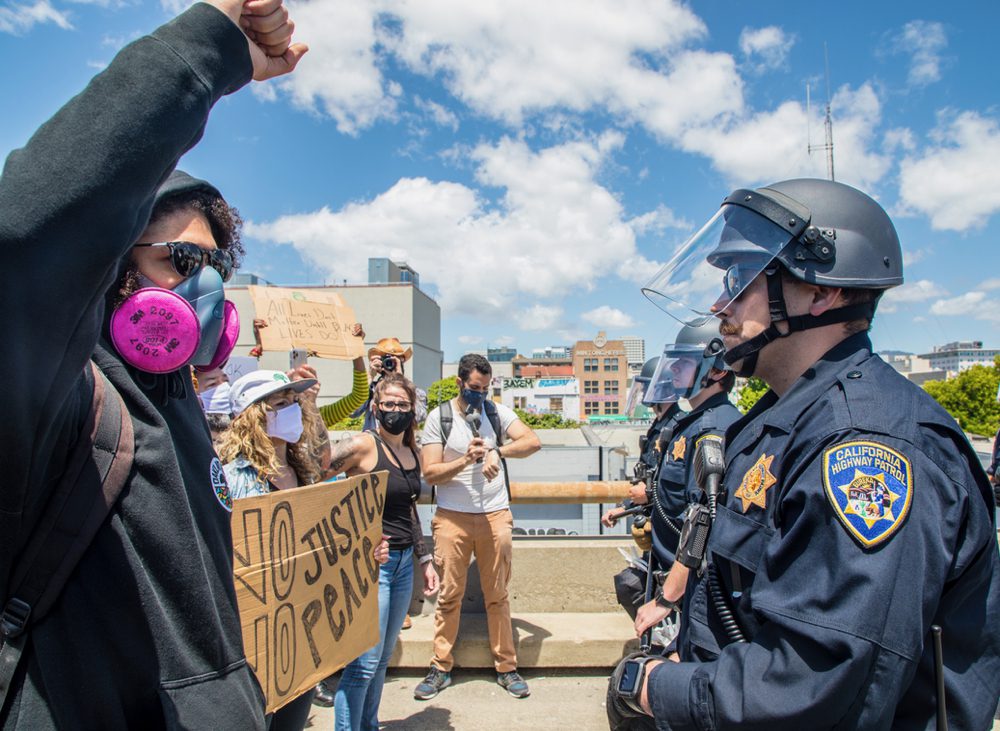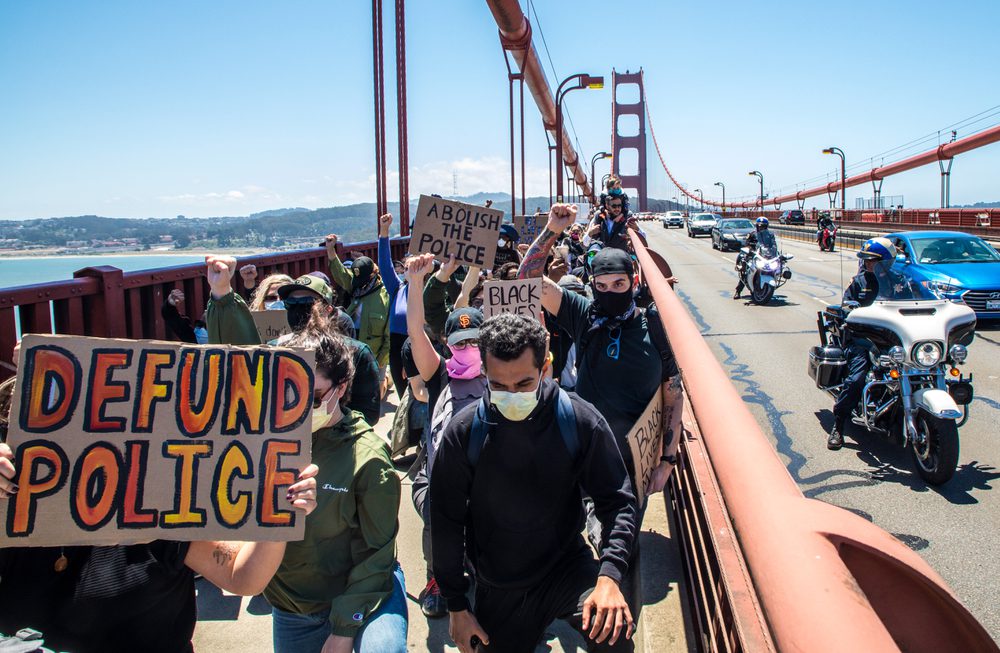In the wake of the nationwide rebellion ignited by the murder of George Floyd in Minneapolis, Minnesota at the hands of police office Derek Chauvin and his three accomplices on the Minneapolis Police Department, the nation — and the world — have risen in outrage. As the nation enters its fourth week of the resulting protests, thousands across the US now take to the streets as Juneteenth commences.
Drawing its origins from June 19, 1865, the day commemorates one of the last acts of emancipation within the US, as enslaved people in Galveston, Texas were notified that the Civil War had ended, and with it, slavery.

Yet the roots of slavery in exploiting lives and labor live on in various manifestations throughout the US, not the least of which is manifested in a corrupted prison complex – one that props up the police terror to which it is intertwined and also one that, as author and Civil Rights advocate Michelle Alexander notes, holds more African-American men in prisons, jails, or on criminal supervision today than were enslaved in the US in 1850.
The resounding call for the acknowledgment and recognition that Black Lives Matter has echoed across city streets – along with all the tangible and actionable solutions that recognition comes with, and is forcing the nation to reckon with its racist past and present – a nation built on stolen land, stolen bodies, and forced labor. While the demands in each of the local communities are by no means monolithic, resounding calls for police demilitarization, police and prison defunding and abolition, and transferring skyrocketing police force funding into programs for the community and community care programs, restorative and transformative justice, and various forms of reparations. The means of direct actions taken to assure these demands are met have ranged in method; from marches, to property destruction, to continued local and national organizing, and ranging from working for change within the political system to giving up on it entirely.

As the Esperanza Project is a green news magazine, I want to note that the environmental movement and the current civil rights movement is woven hand in hand. The interrelation of race and the environment goes further than solely environmental racism, putting onto BIPOC peoples a disproportionate toll from climate change and the environmental and health impacts it comes with; racism and white supremacy are drivers of climate change and the destruction of our natural world itself. As Hop Hopkins penned for Sierra Magazine of the Sierra Club, “You can’t have climate change without sacrifice zones, and you can’t have sacrifice zones without disposable people, and you can’t have disposable people without racism.”
While the calls across the nation are by no means monolithic, here is a lens into the voices echoing through the streets, bridges, and highways of the Bay Area, California, demanding justice for George Floyd, Breonna Taylor, Tony McDade, and so many other Black Americans losing their lives – including during the protests happening now — due to an abuse of power by American police forces and systemic inequities and oppression that have given rise to it. Thousands upon thousands have taken to the streets demanding that concrete steps and actions are taken within their communities so that not only is this loss of life prevented in the future, but so that the presence of life is acknowledged, and so that justice is provided in a country that has failed to do so time and time again throughout history up to the present.
On Juneteenth, demonstrators including those affiliated with the Anti-Fascist protest movement known as Antifa took town three statues in Golden Gate Park, San Francisco, California, despite nearby police presence. Using ropes and ratchet straps, protestors took town the statue of Junipero Serra (founder of the first California Mission, and in part responsible for the genocide of the Indigenous Peoples of what is now called California); Francis Scott Key (the writer of the US national anthem, and also a slave owner); and US General and former US President Ulysses S. Grant (the last US president to personally own enslaved people and who — in desire for mining the untapped gold reserves of the Black Hills — authorized the US Army’s illegal seizure of these sacred mountains from the Lakota People, expelling them from their own lands).
Thousands of protestors in San Francisco, California took to the Golden Gate Bridge, before long flooding over the guard rails and onto its streets, blocking traffic. Protestors echoed the names of George Floyd, Breonna Taylor, Tony McDade and so many other Black Americans who have lost their lives to police violence in the US. Chants for justice for the lost were coupled with demands for actionable steps going forward to ensure this loss of life is put to an end. Across the nation, protestors’ demands range from police defunding and abolition to calling for community care services to rise in their place. This includes diverting certain responses by the police force instead to mental health professionals, domestic violence responders, trained social workers, and special response teams.
Over 15,000 took to the streets of San Francisco for the No Justice No Peace SF March, calling for justice for George Floyd, Breonna Taylor, Tony McDade and so many other Black Americans who have lost their lives to police violence in the US. Police across the nation now kill on average 1,000 people per year with Black Americans three times more likely to be killed than white Americans, according to data compilation by Mapping Police Violence. This has led to major calls for ranging from reform of the police and criminal justice system, all the way to their abolishment due to a belief that neither can be reformed.
More than 40 percent, or around $300 million, of Oakland’s general fund is directed towards the Police Department, far outstripping spending on transportation, health and human services, recreation, and economic development. Across the country, a similar pattern has emerged, with skyrocketing funds leading not to a decrease in police violence, but rather an increased militarization. Funds that could be used towards rebuilding communities and addressing systemic issues arising within them or towards properly training nonviolent de-escalation techniques to our police force are instead being funneled into further militarizing them instead. The federal government’s 1033 Program continues to arm our local police departments with military weaponry and other equipment. The impact of this militarization and the reality of the protestors’ calls for police forces to be demilitarized has been laid bare during the George Floyd protests as the US populace has been met with tear gas, flash-bang or concussion grenades, armored vehicles, both rubber bullets and live rounds, police batons, and dogs, resulting in the injury and death of protestors. (See what your local agency received from the Department of Defense here)
Thousands gathered outside the Oakland Police Department at the Demonstration Against Racism and Police Terror demanding reform, defunding, and or abolition of the Oakland Police Force. As demonstrators took to the streets and flooded the highway while calling the names of Black Lives lost to police violence and echoing calls that Black Lives Matter, they were met with armed cops and armored vehicles. Despite skyrocketing police budgets around the nation — which as of 2017 sits at $115 billion, or triple the funding police forces received in the late 70s after adjusting for inflation — activists and educators say that cops across the nation are still inadequately trained and are failing to properly use de-escalation techniques, instead opting for force. The continued loss of innocent lives despite more money being pumped into the police forces is just one of the reasons that protestors taking to the streets are saying that the police force is irreformable, and so are calling not just for defunding but complete abolition.
Protestors, including those tied to the Anti-Fascist protest movement known as Antifa, took to the streets of Oakland, California as a car in a BMW dealership was set on fire, buildings were looted, and the streets and adjacent buildings covered in spray paint with messages calling for justice for Erik Salgado and others losing their lives to police violence within the US. Protestors confronted dozens of officers lining a section of the street, as rocks, glass bottles, and firecrackers were thrown at the heavily armed officers. Salgado, 23, was killed by the California Highway Patrol in June in East Oakland. While in a suspected stolen vehicle, Salgado and his pregnant girlfriend were both unarmed when shot with a barrage of gunfire, killing Salgado. Salgado’s girlfriend, Brianna Colombo, was seriously injured in the shooting, and bullets pierced her stomach. Her unborn child was lost.
Justice for George Floyd/ F*** the Curfew Protest – Downtown Oakland – Black Lives Matter
Protestors took to the streets of Downtown Oakland in protest of the city’s curfew intended to quell protests rising in the wake of the murders of George Floyd and Breonna Taylor at the hands of the police. Thousands sat in an intersection in the middle of Downtown Oakland, California listening as community members provided a vision for the present and future.
Thousands of protestors took to the streets of Downtown Oakland, California in protest of the city’s curfew intended to quell protests rising in the wake of the murders of George Floyd and Breonna Taylor at the hands of the police. Following the speakers at the Justice for George Floyd / F*** the Curfew Protest, the streets erupted in dancing into the late night — all to music coming from a speaker on a bicycle — hours after the curfew had passed.
Members of the Cal Black Student Union took the stage at the Black Lives Matter Protest in the Martin Luther King Jr. Civic Center Park of Berkeley, California, sharing their visions for the present and future to a crowd of over a thousand protestors demanding justice for Black Lives terrorized by police violence in the US.
Garet Bleir (they/them) is a Sierra editorial fellow and award-winning investigative reporter, documentarian, and photographer covering environmental justice, energy, Indigenous rights, and the borderlands. Their work has been published by Netflix, ZDF, Yahoo News, Center for Public Integrity, Intercontinental Cry, and Indian Country Today. You can follow their work on Instagram, Facebook, and Twitter.
Black Lives Matter BLM Breonna Taylor civil rights Defund The Police George Floyd Juneteenth Oakland Police San Francisco Tony McDade